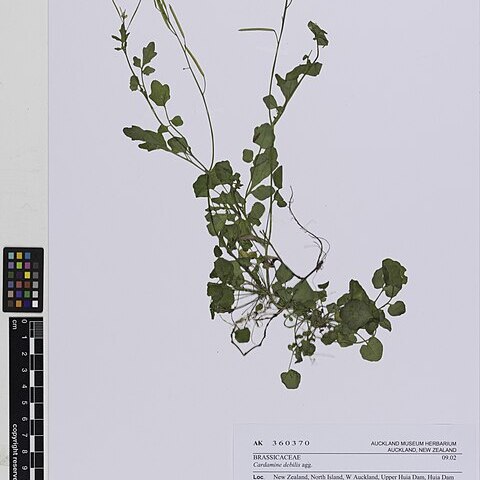Rhizomatous perennial herb, (10)-20-50 cm tall. Stems arising from base, decumbent to suberect, green, glabrous, straight, often bearing persistent crowded lf bases below. Lvs glabrous or hairy, green, thin. Basal lvs dying back or not after fruiting, pinnate or rarely entire; petiole long; terminal leaflet usually > lateral, sinuately lobed, broadly ovate, cordate; lateral leaflets in (0)-1-2-(4) pairs, broadly ovate to suborbicular, unevenly truncate at base, bluntly sinuately lobed to entire; petiolules long. Cauline lvs pinnate, shortly petiolate, similar to basal lvs but often more sharply lobed or toothed. Infl. racemose, 5-10-(20) cm long; peduncle usually glabrous, not flexuous. Pedicels glabrous or hairy, erecto-patent, sometimes spreading, 5-20 mm long at fruiting. Sepals glabrous or hairy, purplish or green, (1)-1.5-2-(2.5) × 0.5-1 mm. Petals white, suberect or spreading, obovate or spathulate, (2)-3-6-(7) × (0.5)-1-2-(3) mm, rarely 0. Stamens 6. Smaller, apetalous fls sometimes produced in late summer and autumn. Silique green, brown, yellow or purplish, erecto-patent, 15-25-(40) × 1.5-2 mm; valves glabrous or hairy; style 1.5-4 mm long. Seeds oblong, green, pale yellow or brown, 1.5-2 mm long.
More
A polymorphic sp. not fully resolvable into distinct vars without breeding and cultural tests, owing to the interplay of genetic and habitat factors. It is closely related to C. hirsuta L., which is naturalized and possibly hybridizes with it. The two vars described below show clear-cut differences. A third, more complex, group is also described. Names are not given in view of the uncertainty as to the type.

